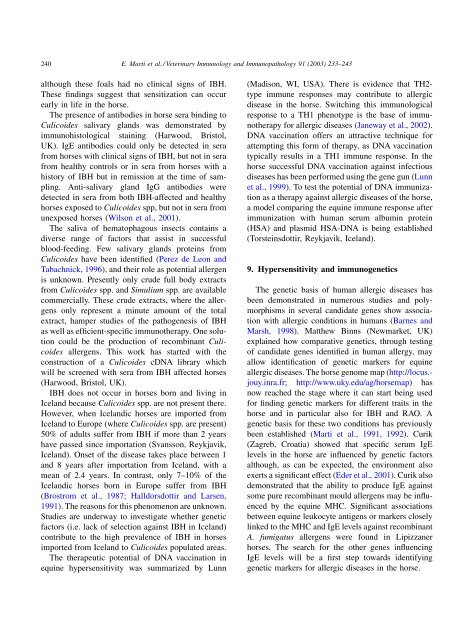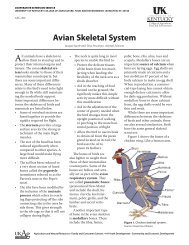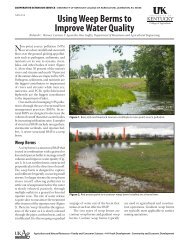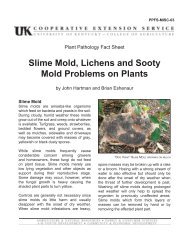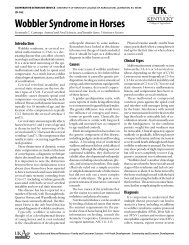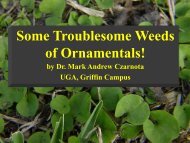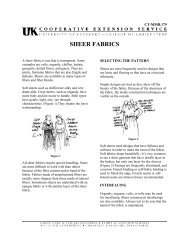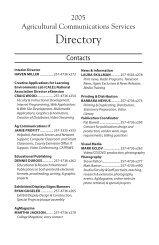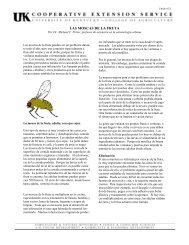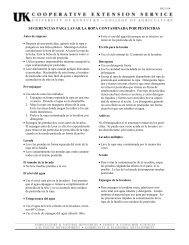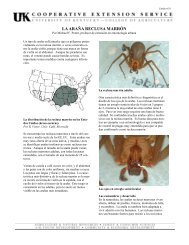Advances in equine immunology: Havemeyer workshop reports from ...
Advances in equine immunology: Havemeyer workshop reports from ...
Advances in equine immunology: Havemeyer workshop reports from ...
Create successful ePaper yourself
Turn your PDF publications into a flip-book with our unique Google optimized e-Paper software.
240 E. Marti et al. / Veter<strong>in</strong>ary Immunology and Immunopathology 91 (2003) 233±243<br />
although these foals had no cl<strong>in</strong>ical signs of IBH.<br />
These ®nd<strong>in</strong>gs suggest that sensitization can occur<br />
early <strong>in</strong> life <strong>in</strong> the horse.<br />
The presence of antibodies <strong>in</strong> horse sera b<strong>in</strong>d<strong>in</strong>g to<br />
Culicoides salivary glands was demonstrated by<br />
immunohistological sta<strong>in</strong><strong>in</strong>g (Harwood, Bristol,<br />
UK). IgE antibodies could only be detected <strong>in</strong> sera<br />
<strong>from</strong> horses with cl<strong>in</strong>ical signs of IBH, but not <strong>in</strong> sera<br />
<strong>from</strong> healthy controls or <strong>in</strong> sera <strong>from</strong> horses with a<br />
history of IBH but <strong>in</strong> remission at the time of sampl<strong>in</strong>g.<br />
Anti-salivary gland IgG antibodies were<br />
detected <strong>in</strong> sera <strong>from</strong> both IBH-affected and healthy<br />
horses exposed to Culicoides spp, but not <strong>in</strong> sera <strong>from</strong><br />
unexposed horses (Wilson et al., 2001).<br />
The saliva of hematophagous <strong>in</strong>sects conta<strong>in</strong>s a<br />
diverse range of factors that assist <strong>in</strong> successful<br />
blood-feed<strong>in</strong>g. Few salivary glands prote<strong>in</strong>s <strong>from</strong><br />
Culicoides have been identi®ed (Perez de Leon and<br />
Tabachnick, 1996), and their role as potential allergen<br />
is unknown. Presently only crude full body extracts<br />
<strong>from</strong> Culicoides spp. and Simulium spp. are available<br />
commercially. These crude extracts, where the allergens<br />
only represent a m<strong>in</strong>ute amount of the total<br />
extract, hamper studies of the pathogenesis of IBH<br />
as well as ef®cient-speci®c immunotherapy. One solution<br />
could be the production of recomb<strong>in</strong>ant Culicoides<br />
allergens. This work has started with the<br />
construction of a Culicoides cDNA library which<br />
will be screened with sera <strong>from</strong> IBH affected horses<br />
(Harwood, Bristol, UK).<br />
IBH does not occur <strong>in</strong> horses born and liv<strong>in</strong>g <strong>in</strong><br />
Iceland because Culicoides spp. are not present there.<br />
However, when Icelandic horses are imported <strong>from</strong><br />
Iceland to Europe (where Culicoides spp. are present)<br />
50% of adults suffer <strong>from</strong> IBH if more than 2 years<br />
have passed s<strong>in</strong>ce importation (Svansson, Reykjavik,<br />
Iceland). Onset of the disease takes place between 1<br />
and 8 years after importation <strong>from</strong> Iceland, with a<br />
mean of 2.4 years. In contrast, only 7±10% of the<br />
Icelandic horses born <strong>in</strong> Europe suffer <strong>from</strong> IBH<br />
(Brostrom et al., 1987; Halldorsdottir and Larsen,<br />
1991). The reasons for this phenomenon are unknown.<br />
Studies are underway to <strong>in</strong>vestigate whether genetic<br />
factors (i.e. lack of selection aga<strong>in</strong>st IBH <strong>in</strong> Iceland)<br />
contribute to the high prevalence of IBH <strong>in</strong> horses<br />
imported <strong>from</strong> Iceland to Culicoides populated areas.<br />
The therapeutic potential of DNA vacc<strong>in</strong>ation <strong>in</strong><br />
equ<strong>in</strong>e hypersensitivity was summarized by Lunn<br />
(Madison, WI, USA). There is evidence that TH2type<br />
immune responses may contribute to allergic<br />
disease <strong>in</strong> the horse. Switch<strong>in</strong>g this immunological<br />
response to a TH1 phenotype is the base of immunotherapy<br />
for allergic diseases (Janeway et al., 2002).<br />
DNA vacc<strong>in</strong>ation offers an attractive technique for<br />
attempt<strong>in</strong>g this form of therapy, as DNA vacc<strong>in</strong>ation<br />
typically results <strong>in</strong> a TH1 immune response. In the<br />
horse successful DNA vacc<strong>in</strong>ation aga<strong>in</strong>st <strong>in</strong>fectious<br />
diseases has been performed us<strong>in</strong>g the gene gun (Lunn<br />
et al., 1999). To test the potential of DNA immunization<br />
as a therapy aga<strong>in</strong>st allergic diseases of the horse,<br />
a model compar<strong>in</strong>g the equ<strong>in</strong>e immune response after<br />
immunization with human serum album<strong>in</strong> prote<strong>in</strong><br />
(HSA) and plasmid HSA-DNA is be<strong>in</strong>g established<br />
(Torste<strong>in</strong>sdottir, Reykjavik, Iceland).<br />
9. Hypersensitivity and immunogenetics<br />
The genetic basis of human allergic diseases has<br />
been demonstrated <strong>in</strong> numerous studies and polymorphisms<br />
<strong>in</strong> several candidate genes show association<br />
with allergic conditions <strong>in</strong> humans (Barnes and<br />
Marsh, 1998). Matthew B<strong>in</strong>ns (Newmarket, UK)<br />
expla<strong>in</strong>ed how comparative genetics, through test<strong>in</strong>g<br />
of candidate genes identi®ed <strong>in</strong> human allergy, may<br />
allow identi®cation of genetic markers for equ<strong>in</strong>e<br />
allergic diseases. The horse genome map (http://locus.jouy.<strong>in</strong>ra.fr;<br />
http://www.uky.edu/ag/horsemap) has<br />
now reached the stage where it can start be<strong>in</strong>g used<br />
for ®nd<strong>in</strong>g genetic markers for different traits <strong>in</strong> the<br />
horse and <strong>in</strong> particular also for IBH and RAO. A<br />
genetic basis for these two conditions has previously<br />
been established (Marti et al., 1991, 1992). Curik<br />
(Zagreb, Croatia) showed that speci®c serum IgE<br />
levels <strong>in</strong> the horse are <strong>in</strong>¯uenced by genetic factors<br />
although, as can be expected, the environment also<br />
exerts a signi®cant effect (Eder et al., 2001). Curik also<br />
demonstrated that the ability to produce IgE aga<strong>in</strong>st<br />
some pure recomb<strong>in</strong>ant mould allergens may be <strong>in</strong>¯uenced<br />
by the equ<strong>in</strong>e MHC. Signi®cant associations<br />
between equ<strong>in</strong>e leukocyte antigens or markers closely<br />
l<strong>in</strong>ked to the MHC and IgE levels aga<strong>in</strong>st recomb<strong>in</strong>ant<br />
A. fumigatus allergens were found <strong>in</strong> Lipizzaner<br />
horses. The search for the other genes <strong>in</strong>¯uenc<strong>in</strong>g<br />
IgE levels will be a ®rst step towards identify<strong>in</strong>g<br />
genetic markers for allergic diseases <strong>in</strong> the horse.


